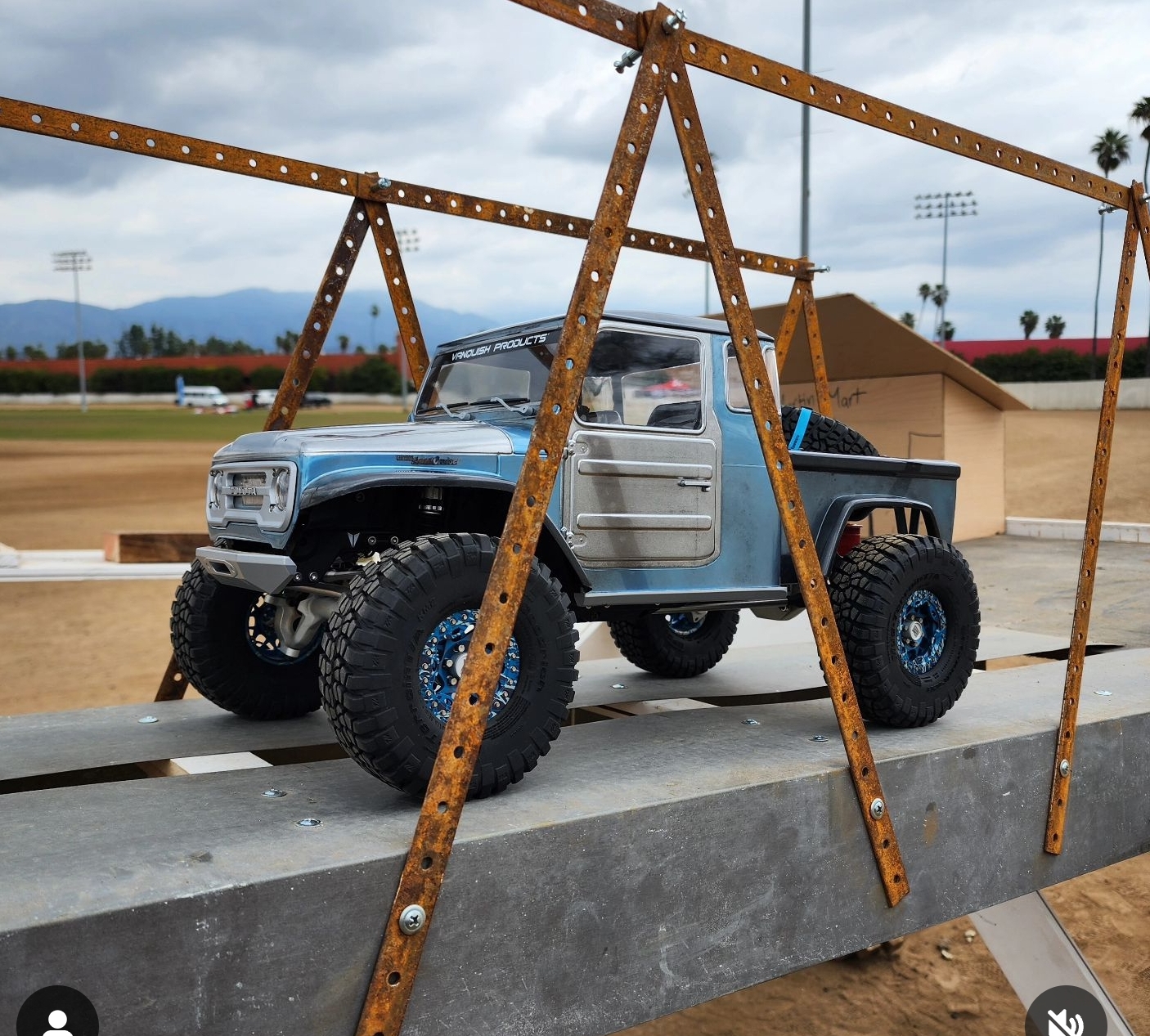What is an RC Crawler?
Rock crawling has always been about conquering tough terrains and overcoming impossible obstacles. This thrill is captured by a specific vehicle type known as the RC crawler. These machines are engineered to mimic the rock-crawling like the full-sized vehicles, such as the iconic Land Rover Defender and the Jeep Wrangler Unlimited Rubicon, but in a more accessible, scaled-down versions.
The Basics of RC Crawlers
An RC crawler is a type of radio-controlled vehicle designed specifically for rock crawling. These vehicles, such as the popular 4WD rock crawler and the 4×4 rock crawler, are built to navigate rough terrain with ease. The main features that set RC crawlers apart from other types of RC vehicles include a high torque motor type, usually brushed for reliability and control, and specialized tires that provide superior grip on rocky surfaces.
Motor Type and Performance in RC Crawlers
The choice of motor significantly influences an RC crawler’s performance. Most crawlers use a brushed motor type to balance power and control. This allows the crawler to navigate steep inclines and rough terrain with precision. The motor, combined with a suitable pinion tooth count, ensures the vehicle has enough torque to overcome obstacles while maintaining a manageable speed.
Scale and Realism
RC crawlers are often available in various scales, with detailed models replicating the Land Rover Defender, Jeep Wrangler Unlimited, and other off-road icons. Brands like Axial are known for their attention to detail, offering models like the SCX10 III and the Axial Wraith, which perform exceptionally well on tough terrains and closely resemble their full-sized counterparts.
Completion Level and Customization
A lot of people who like RC crawling love customizing their vehicles and making them their “own”. Vehicles come in different completion levels, with “ready-to-run” (RTR) models being the most common. These models require minimal setup, making them ideal for beginners. For the more experienced hobbyist, there are kits that allow for extensive customization, from the pinion tooth count to the outer wheel diameter and even the connector type.
Wheels, Tires, and Suspension for RC Crawling
RC crawlers are dependent on their wheels and tires. The outer wheel diameter and the inner tire profile are crucial for navigating rocks and other obstacles. Larger diameters and aggressive tire treads improve grip and clearance, which is essential for serious rock crawling. The suspension system, often adjustable, plays a vital role in the crawler’s ability to flex and articulate over obstacles.
Navigating the Hobby
For those new to RC crawling, Horizon Hobby and similar retailers offer a wide range of vehicles, parts, and accessories. Whether you’re looking for a monster truck for rugged play or a scale replica for detailed rock crawling, there’s an RC vehicle to suit every preference. With features like easy pay and gift cards.

Deep Dive into the Technicalities
Understanding the details of RC crawlers can significantly enhance your experience. Let’s explore some of the key technical aspects that make these vehicles rock-crawling champions.
Pinion Tooth Count and Its Impact
The pinion tooth count in an RC crawler is for determining the vehicle’s overall gear ratio. A higher tooth count can lead to faster speeds but at the cost of torque. On the other hand, a lower tooth count increases torque, essential for rock crawling, allowing the vehicle to push through obstacles with greater force. Adjusting the pinion tooth count is a common way to fine-tune performance based on specific crawling conditions or personal preference.
Wheel Diameter and Terrain Handling
The outer wheel diameter of an RC crawler affects not just its scale appearance but also how it handles various terrains. Larger wheels can overcome bigger obstacles but might affect the vehicle’s center of gravity. It’s a balance between achieving that realistic look and maintaining optimal performance. Inner tire composition and tread pattern also play a significant role in how well the crawler grips onto surfaces, enabling it to ascend steep, rocky paths with ease.
True Completion Level Ready-to-Run (RTR)
While the term “ready-to-run” might imply a complete setup with no additional work needed, true completion level varies. Some RTR models might still require minor adjustments, battery installations, or even aesthetic customizations to fully meet the owner’s expectations. Understanding what’s truly included and what might be needed post-purchase can save time and ensure immediate enjoyment upon unboxing.
The Role of 4WD in Rock Crawling
The 4WD (four-wheel drive) system in rock crawlers is fundamental to their ability to navigate challenging terrains. This system provides power to all four wheels, distributing torque evenly and ensuring that if one wheel lifts off the ground, the others can still maintain traction and drive. This is particularly useful in rock crawling, where uneven surfaces are the norms.
The Community and Resources
The RC crawler community is vast and welcoming, with countless forums, social media groups, and YouTube channels dedicated to sharing tips, modifications, and crawling adventures. For beginners, these resources can be invaluable in learning how to upgrade their vehicles, troubleshoot issues, or even find new crawling spots. Brands like Axial not only refine their models based on community feedback but also actively participate in events and discussions, further enriching the hobbyist’s experience.
Navigating the Future of RC Crawling
As we move forward, the future of RC crawling looks bright, with technological advancements and community engagement driving the hobby to new heights. Innovations in materials, electronics, and design are set to offer even more realistic and capable crawlers, blurring the lines between model and machine, between hobby and passion.
Technological Advancements
The continuous improvement in battery technology, motor efficiency, and electronic speed controllers (ESC) promises to enhance the performance and endurance of RC crawlers. Future models may feature more advanced telemetry systems, allowing hobbyists to monitor vehicle stats in real time, adjust settings on the fly, and even simulate real-world off-roading experiences through augmented reality (AR) platforms.
With the advent of 3D printing, customizing and creating parts has become more accessible. Hobbyists can now design and print unique components, offering an unprecedented level of customization. From personalized body shells to specialized suspension components, the possibilities are endless.
Environmental Considerations
As with many hobbies, sustainability becomes a focal point for the RC crawling community. The shift towards more eco-friendly materials and rechargeable battery systems reflects a growing awareness of environmental impact. Manufacturers and hobbyists alike are exploring ways to reduce waste, recycle old parts, and ensure that the thrill of rock crawling leaves a minimal ecological footprint.
Community Growth and Events
The RC crawling community continues to grow, fostered by local and global events that bring enthusiasts together. Competitions, meet-ups, and workshops not only offer a platform for showcasing skills and models but also for sharing knowledge and fostering friendships. The community aspect of RC crawling is a significant draw, with many finding joy not just in the vehicles themselves but in the shared experiences they bring.
The Role of Brands and Retailers
Brands like Axial play a crucial role in the development of the hobby, pushing the boundaries of what’s possible with each new model. Retailers, including Horizon Hobby, offer a gateway for newcomers, providing everything from starter kits to advanced models, along with expert advice and support. The relationship between brands, retailers, and the community is symbiotic, with each playing a part in driving the hobby forward.
Wrapping Up the Crawl
As an RC crawler enthusiast, the journey is as much about overcoming physical obstacles with your vehicle as it is about personal growth and community. The hobby offers a unique blend of technical challenge, creative expression, and camaraderie. Whether you’re meticulously adjusting your vehicle’s pinion tooth count for the perfect torque or sharing tips with a newcomer, every aspect of RC crawling enriches the experience.
Looking ahead, the future of RC crawling is not just about the vehicles we drive but about the memories we create, the friendships we forge, and the trails we leave behind. It’s about embracing innovation while respecting the environment, and most importantly, it’s about bringing people together, united by a shared passion for conquering the rocks. So, here’s to the crawlers, the builders, the dreamers, and the adventurers — may your trails be rocky, and your spirits high.
The world of RC crawlers is as diverse as it is technical. Whether it’s adjusting the pinion tooth count for better torque, customizing the outer wheel diameter for a particular terrain, or choosing between brushed and brushless motor types, each decision shapes the crawling experience. With models like the SCX10 III base camp offering a solid foundation, enthusiasts can dive deep into customization, turning their crawlers into unique masterpieces that reflect their personal touch.
Rock crawling with RC vehicles isn’t just about the challenge; it’s about the creativity, technical skill, and community that come with it. From the meticulous adjustments before a run to the camaraderie of crawling with friends, this hobby offers a fulfilling blend of engineering and adventure. As we look ahead, the evolution of RC crawlers continues, promising even more realistic, capable, and thrilling vehicles ready to take on the rocks. So, whether you’re a seasoned crawler or just starting, there’s never been a better time to explore the rugged, rocky world of RC crawling.
I am a massive fan of anything that is remote controlled. This stems from my childhood when my Grandfather would take me to a local RC flying club and I would dream about having my own RC models someday.
